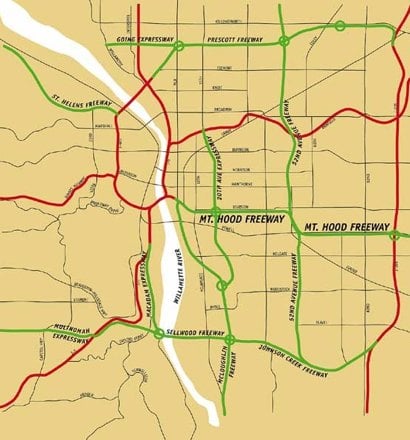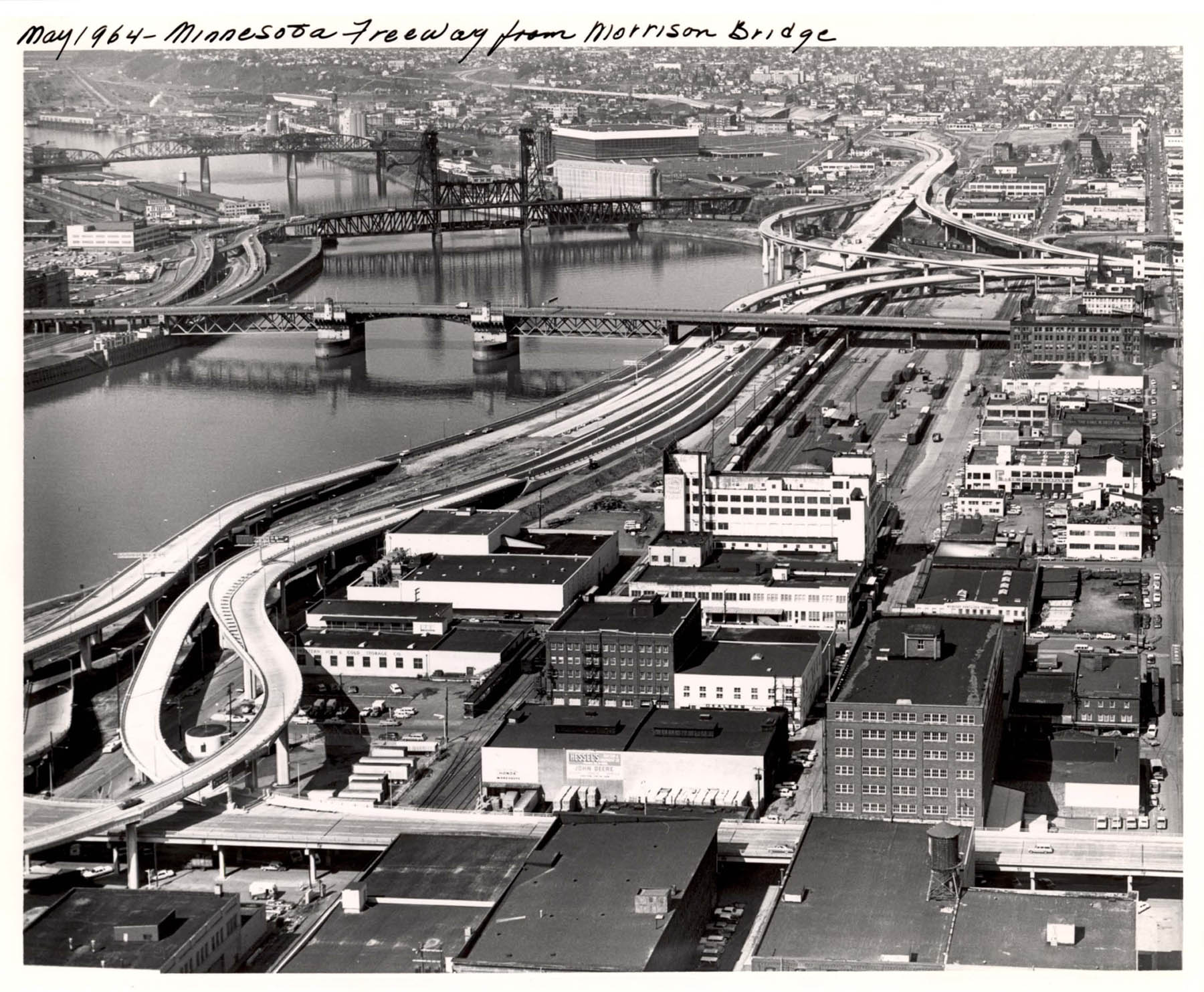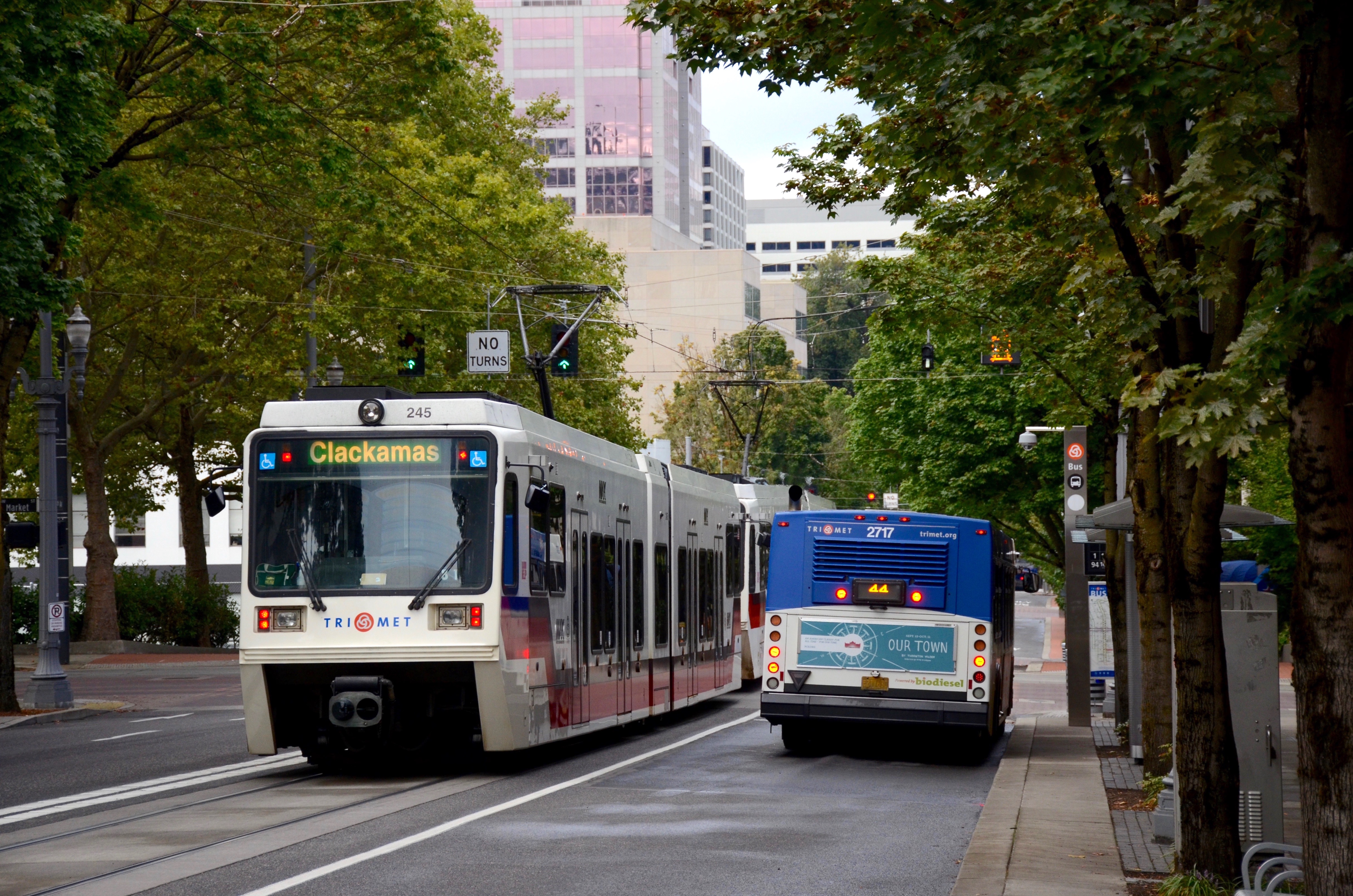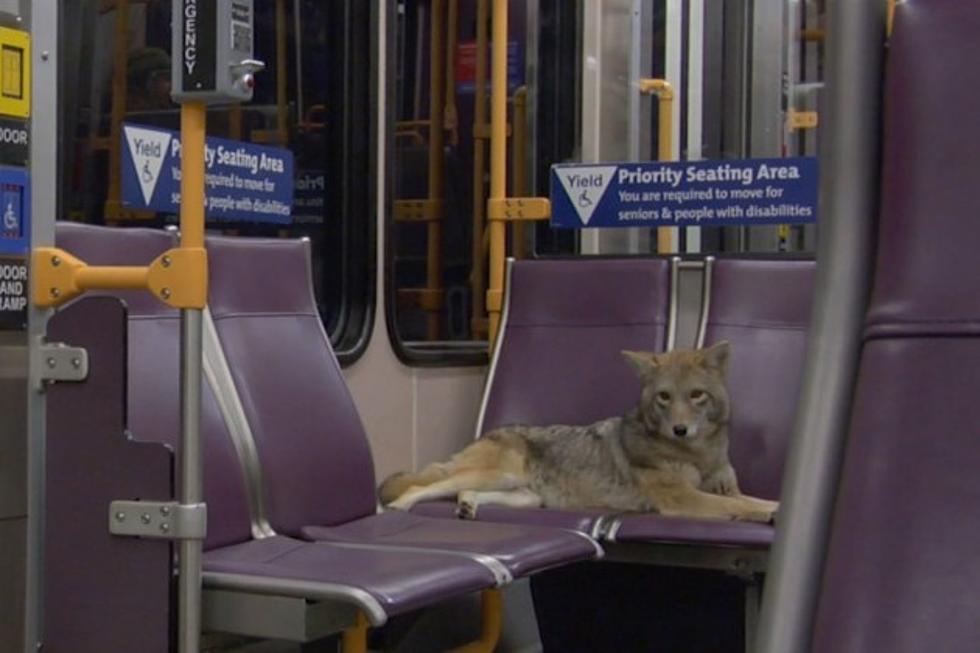-----
 |
| Robert Moses' plan to criss-cross Portland with a bunch of freeways, 1955 (BikePortland.org) |
 |
| The Minnesota Freeway from Morrison Bridge, 1964 (Vintage Portland) |
By 1970s, freeways were socially taboo in the Rose City, but the council was still shacked with funds provided by the Federal-Aid Highway Act of 1973. So, to allocate those funds for better use, the city's Trimet public transit agency began studies to expand public transit. The highway division pushed for more bus services, but then-governor Tom McCall sided with light rail following a damning environmental impact statement that was later released. Five years later, in 1978, Trimet approved of the new "Banfield Light Rail Project" with a 15 mile section between 11th Avenue in Portland and Cleveland Avenue in Gresham slated for construction in 1982.
 |
| The MAX opens for operation, 1982 (Portland Trimet) |
At the same time, Oregon Metro (under the city of Portland) noted the East-West corridor opened by the MAX and decided it would be a good idea to introduce light rail to Clackamas County. These routes would either go from downtown Portland to Oregon City via Milwaukie (utilizing some original sections of the Oregon Electric) or from Clackamas Town Center to the Portland Airport. The studies of both routes were completed in 1993, but unfortunately a tax proposal to extend the line to Washington state had failed. (This is, in my opinion, the biggest shortcoming of the line considering Vancouver, Washington is a suburb of Portland in all but status and name.)
1993 also facilitated the building of the MAX's biggest piece of infrastructure yet: the 18-mile, volcano-punching Robertson Tunnel under the West Hills volcanic chain. Boring started from Kings Hill and Salmon Street on the West Hills' east side, then out to the current Hatfield Government center. With the line from Gresham to Hillsboro stretching 33 miles, the complete line opened as a through service in 1998.
 |
| The MAX Red Line to PDX opens on Sept. 10, 2001 (Portland Trimet) |
The Airport Line would eventually be routed onto the Blue Line to alleviate overcrowding on the mainline, also creating a one-seat commute for people West of the West Hills to get to the airport from Beaverton Town Center. The "North-South" proposal from 1993 was also revisited, becoming the "Interstate MAX" project in 2001 and planned to run just in North Portland only: from the Rose Quarter to the Portland Expo Center. Urban renewal support (real estate for hipsters) was drummed up to minimize costs and in 2004, the Yellow Line officially opened, also being the third line to run across the Steel Bridge (along with the Red and Blue Lines).
 |
| A MAX train to Hillsboro crosses the Steel Bridge (Wikipedia) |
 |
| A MAX Type 1 leads a Type 2 over the Tilikum Crossing in 2016, bound for Milwaukie (Steve Morgan) |
The current final pieces of the Trimet MAX were opened in 2003, starting with the completion of the Yellow Line, that being the Green Line from Clackamas Town Center and the Orange Line from Portland to Milwaukie via Hawthorne Bridge. The Green Line opened on September 12, 2009, sharing alignments with the other four lines above, and brought about a revitilization of the Portland Transit Mall, a pair of one-way transit corridors that were originally operated by just buses. The Orange Line would make use of the Tilikum Crossing, a bridge over the Willamette that would open only to bus, light rail, bicycle, and pedestrian traffic between Portland State Universty (PSU) and the Oregon Rail Heritage Foundation (ORHF) and Oregon Museum of Science and Industry (OMSI) just north of the former.
 |
| Siemens Type 2 245 shares the Portland Mall with a bus, bound for Clackamas (Steve Morgan) |
 |
| (The Oregonian) |
Currently, the MAX is looking to improve the Red Line by using the Westside Extension to reach Hillsboro airport from Beaverton Transit Center that would put 10 more stations on the line. Tualatin and Tigard are also planned to get extensions from PSU, following Oregon Route 99. Three stations are also set to close in the Rose Quarter by this year, with two Mall stations being shut down in order to speed up service and Kings Hill/Salmon Street facing a one-year pilot closure by March 2020. Anything for efficiency in America's fourth-busiest transit system.
And finally, the Portland MAX's biggest claim to fame came in February 13, 2001, when an errant coyote boarded an Airport Service on the Red Line much to the bewilderment of the passengers. Eventually he was shooed away by Animal Services, but the event was significant enough that Modest Mouse (themselves from across the river in Washington State) immortalised the event in 2015 by making a music video where a coyote takes a couple MAX trains in the wee hours of the morning to the Rose Quarter. Watch it here if you are interested.
 |
| Obviously, coyotes take priority. (Modest Mouse) |
-----
Thank you for reading this delayed Trolley Tuesday installment! Come back tomorrow where we finish the month off with a report on the history of the Oregon Electric Railway Museum, then check back Friday where the first "From the Archives" episode will be posted here! Now ride safe out there, and save the coyotes.


No comments:
Post a Comment